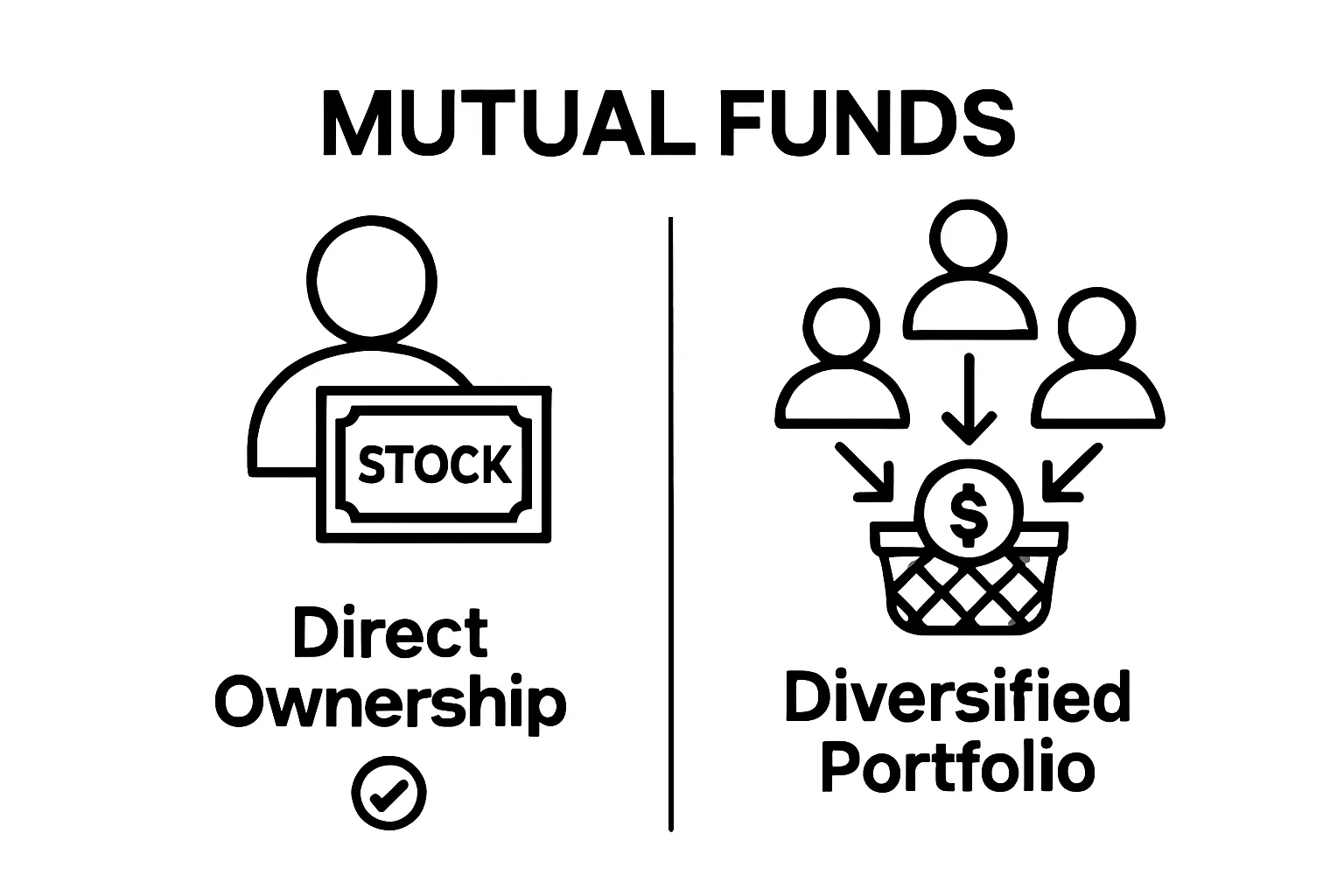Everyone wants their money to work harder, and most people know that stocks and mutual funds are two major options for growing wealth. But nearly 58 percent of Americans own stocks, while only about 45 percent invest in mutual funds. Most assume mutual funds are playing it safe and stocks are only for risk-takers. Turns out, their differences go way beyond risk, and understanding how each truly works can change your entire investment approach.
Table of Contents
- What Are Mutual Funds And Stocks?
- The Importance Of Understanding Different Investments
- How Mutual Funds And Stocks Generate Returns
- Key Differences Between Mutual Funds And Stocks
- When To Choose Mutual Funds Over Stocks And Vice Versa
Quick Summary
| Takeaway | Explanation |
|---|---|
| Stocks offer direct ownership in companies | Buying stocks means acquiring shares and potential voting rights in a corporation. |
| Mutual funds provide professional management | Investors benefit from experts managing diversified portfolios, suitable for those with less market knowledge. |
| Consider risk tolerance when investing | Understanding personal risk levels helps tailor investment choices and balance portfolios accordingly. |
| Diversification reduces investment risk | Spreading money across different asset types lowers the impact of poor performance in a single investment. |
| Match investment choice to financial goals | Aligning investment strategies with long-term objectives ensures better planning and resource allocation. |
What are Mutual Funds and Stocks?
Investing offers multiple pathways for individuals to grow their wealth, with mutual funds and stocks representing two fundamental investment vehicles. Understanding these financial instruments is crucial for making informed investment decisions.
Understanding Stocks
Stocks represent ownership shares in a publicly traded company. When you purchase a stock, you essentially buy a small piece of that corporation. These shares can be bought and sold on stock exchanges like the New York Stock Exchange (NYSE) or NASDAQ.
Stocks provide investors two primary ways to generate returns:
- Capital Appreciation: When the company’s value increases, the stock price rises
- Dividend Income: Some companies distribute a portion of their profits directly to shareholders
According to the U.S. Securities and Exchange Commission, investing in individual stocks requires careful research and understanding of company performance, market conditions, and potential risks.
Exploring Mutual Funds
Mutual funds represent a pooled investment strategy where multiple investors combine their money to purchase a diversified portfolio of stocks, bonds, or other securities. Professional fund managers make investment decisions on behalf of shareholders, aiming to generate returns while managing risk.
Key characteristics of mutual funds include:
- Professional management
- Built-in diversification
- Accessibility for investors with smaller capital
Morningstar highlights that mutual funds can help investors spread risk across multiple investments, potentially providing more stable returns compared to individual stock picking.
While both stocks and mutual funds offer opportunities for financial growth, they differ significantly in management, risk profile, and investment approach. Understanding these nuanced differences empowers investors to make strategic choices aligned with their financial goals and risk tolerance.
The Importance of Understanding Different Investments
Investing is more than just allocating money into financial instruments. Strategic investment knowledge empowers individuals to make informed decisions, manage risks effectively, and build long-term financial stability. Understanding different investment options is crucial for creating a robust financial strategy.
Mitigating Investment Risks
Every investment carries inherent risks, and comprehending these risks is fundamental to successful financial planning. By understanding the characteristics of various investment vehicles, you can develop a more balanced and resilient portfolio. Different investments react differently to market conditions, economic changes, and global events.
Key risk management considerations include:
- Evaluating potential returns against possible losses
- Understanding your personal risk tolerance
- Recognizing how different investments correlate with each other
According to the Consumer Financial Protection Bureau, investors who deeply understand their investment options can make more strategic financial choices.
Building a Diversified Portfolio
Diversification is a powerful strategy for managing investment risk. By spreading investments across multiple asset types, sectors, and geographic regions, you reduce the potential impact of poor performance in any single investment. Mutual funds and stocks each play unique roles in creating a well-rounded investment approach.
Effective diversification strategies involve:


- Mixing different asset classes
- Balancing high-risk and low-risk investments
- Regularly rebalancing your portfolio
For those looking to dive deeper into portfolio construction, learn more about building an investment portfolio to optimize your financial strategy.
Investment education is an ongoing process. Markets evolve, economic landscapes shift, and personal financial goals change. Continuous learning and adaptability are key to navigating the complex world of investments successfully.
How Mutual Funds and Stocks Generate Returns
Investors seek financial growth through various investment strategies, with stocks and mutual funds offering distinct paths to generating returns. Understanding how these investment vehicles create value is crucial for making informed financial decisions.
Stock Return Mechanisms
Stocks generate returns through two primary methods: capital appreciation and dividend payments. Capital appreciation occurs when the market value of a stock increases over time, allowing investors to sell shares at a higher price than their original purchase cost.
Key factors influencing stock returns include:
- Company financial performance
- Market conditions and economic trends
- Industry sector dynamics
- Investor sentiment and market perception
The U.S. Securities and Exchange Commission emphasizes that stock returns are directly tied to the company’s underlying business performance and broader market conditions.
Mutual Fund Return Strategies
Mutual funds generate returns through a pooled investment approach, where professional managers strategically invest across multiple securities. Returns are typically realized through two primary channels: capital gains and dividend distributions.
Important aspects of mutual fund returns include:
- Professional management of investment portfolio
- Diversification across multiple securities
- Potential for more stable returns compared to individual stock picking
For investors looking to understand the nuanced world of investment returns, check out our comprehensive guide on investment returns to gain deeper insights.
While both stocks and mutual funds aim to generate financial growth, they differ significantly in risk profile, management approach, and potential returns. Investors must carefully evaluate their financial goals, risk tolerance, and investment horizon when choosing between these investment vehicles.
The table below outlines how stocks and mutual funds generate returns, highlighting the mechanisms that drive profits for each investment type.
| Investment Type | Main Return Sources | Who Manages Portfolio | Diversification Level |
|---|---|---|---|
| Stocks | Capital appreciation, dividends | Individual investor | Entirely up to investor |
| Mutual Funds | Capital gains, dividend distributions | Professional manager | High (across many assets/securities) |
Key Differences Between Mutual Funds and Stocks
Investment vehicles like stocks and mutual funds offer distinct pathways for building wealth, each with unique characteristics that appeal to different investor profiles and financial goals. Understanding these fundamental differences helps investors make more strategic investment decisions.
Below is a comparison table summarizing the key differences between mutual funds and stocks to help you quickly understand their main features and distinctions.
| Feature | Mutual Funds | Stocks |
|---|---|---|
| Ownership | Fractional ownership across multiple securities | Direct ownership in a specific company |
| Management | Professional fund manager makes investment decisions | Investor is responsible for making decisions |
| Diversification | Built-in, spreads risk across many assets | Depends on investor, often limited per investment |
| Risk Level | Typically lower due to diversification | Generally higher, varies by company |
| Investor Control | Limited, cannot select individual assets | Full, chooses which stocks to buy/sell |
| Minimum Investment | Usually low, accessible to small investors | Can be high depending on share price |
| Return Drivers | Pooled asset performance, manager skill | Company performance, market trends |


Ownership and Control
Stocks represent direct ownership in a specific company, giving investors a tangible stake in its performance. When you purchase a stock, you become a partial owner with potential voting rights in shareholder meetings. Mutual funds, by contrast, represent ownership in a professionally managed portfolio of multiple securities.
Key ownership distinctions include:
- Direct company ownership for stocks
- Fractional ownership across multiple securities in mutual funds
- Varying levels of investor control and decision making
The U.S. Securities and Exchange Commission highlights that mutual funds provide investors with a more diversified approach compared to individual stock investments.
Risk and Management
Risk management differs significantly between stocks and mutual funds. Individual stocks carry company-specific risks and require active monitoring, while mutual funds offer built-in diversification through professional management. Mutual fund managers spread investments across various securities, potentially reducing overall portfolio volatility.
Critical risk management considerations involve:
- Level of investor involvement required
- Complexity of investment tracking
- Potential for portfolio diversification
For investors seeking a deeper understanding of investment strategies, explore our comprehensive guide on building an investment portfolio to optimize your financial approach.
While both investment types aim to generate returns, they cater to different investor needs. Stocks offer direct market engagement and potentially higher returns, whereas mutual funds provide professional management and inherent risk mitigation. Successful investing requires understanding these nuanced differences and aligning them with personal financial objectives.
When to Choose Mutual Funds Over Stocks and Vice Versa
Navigating investment choices requires understanding when to leverage mutual funds or individual stocks based on your financial goals, risk tolerance, and investment expertise. Making informed decisions can significantly impact your long-term financial success.
Investor Experience and Knowledge
The decision between stocks and mutual funds often depends on your investment experience and market understanding. Individual stocks demand more active management and deeper financial knowledge, while mutual funds offer a more hands-off approach for less experienced investors.
Consider choosing individual stocks if you:
- Have substantial market research skills
- Can dedicate time to monitoring investments
- Understand complex financial statements
- Possess higher risk tolerance
Morningstar recommends that novice investors typically benefit more from mutual funds due to their built-in diversification and professional management.
Financial Goals and Investment Horizon
Your investment timeline and financial objectives play crucial roles in selecting the right investment vehicle. Short-term investors might prefer the stability of mutual funds, while long-term investors could benefit from strategic individual stock selections.
Key considerations for investment selection include:
- Long-term wealth accumulation goals
- Desired level of portfolio complexity
- Personal time available for investment management
- Current financial resources
For investors seeking to optimize their investment strategy, explore our guide on safe investment options to refine your approach.
Ultimately, many successful investors utilize a balanced approach, combining mutual funds for stability and individual stocks for potential high-growth opportunities. The most effective strategy depends on individual financial circumstances, risk appetite, and investment knowledge.
Take Control of Your Investment Choices Today
It can be overwhelming to compare mutual funds and individual stocks, especially when the risks and strategies feel complex. Many readers face challenges balancing the desire for growth with the fear of making costly mistakes. If you find yourself unsure about when to use mutual funds for stability or when to pick individual stocks for higher returns, you are not alone. This article has shown that understanding ownership, portfolio diversification, and risk management are key to making confident choices.
Ready to turn your financial knowledge into smart action? Get practical guidance tailored to your needs from our experts at finblog.com. If you want to strengthen your portfolio, explore our in-depth resource on building an investment portfolio or discover safe investment options to match your risk level. Do not leave your future to chance. Visit finblog.com now and connect with the advice you need to invest wisely.
Frequently Asked Questions
What are the main differences between mutual funds and stocks?
Mutual funds provide a diversified portfolio managed by professionals, offering built-in risk management. Stocks represent direct ownership in a company and can offer higher potential returns but also come with greater volatility and risks associated with individual companies.
How do mutual funds generate returns?
Mutual funds generate returns mainly through capital gains and dividend distributions from a diversified portfolio of different securities managed by professionals.
What factors should I consider when deciding between mutual funds and stocks?
Consider your investment experience, risk tolerance, financial goals, and the time you can dedicate to managing your investments. Mutual funds are suitable for those seeking a hands-off approach, while stocks may appeal to those comfortable with active management and market research.
Can I include both mutual funds and stocks in my investment portfolio?
Yes, many investors benefit from a balanced approach by combining both mutual funds for stability and individual stocks for potential high growth, aligning with their financial objectives and risk appetite.










